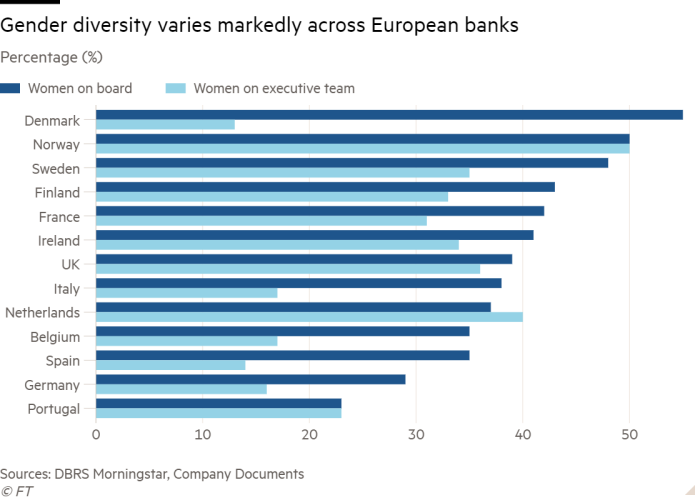
European banks are making slow progress on gender diversity, with women in just over a quarter of executive roles and 37 per cent of board seats last year, compared with 20 and 35 per cent respectively in 2020.
The research by DBRS Morningstar, based on data from 43 banks across Europe and the UK, also showed considerable variation between countries, with German and Portuguese banks at the bottom for women on boards and in executive teams.
Quotas “may have helped to boost female board representation, but management positions and positions of executive decision making continue to show higher participation by men”, wrote the DBRS Morningstar analysts.
Nordic countries showed the greatest gender diversity on boards, with a 55 per cent figure for women in Denmark, though only 13 per cent of Danish bank executive roles were filled by women, and 50 per cent for the Norwegian banks. By contrast, only 23 per cent of board members in Portuguese banks were women, and 29 per cent in German ones.
Just five banks — UK high street bank Lloyds and building society Nationwide, Norwegian lender DNB, Sweden’s Handelsbanken and Bank of Ireland — had female chief executives in 2021. Only four had a female chair, with DNB the only institution to have both. Across the entire sample of banks, only 26 per cent of executive roles were held by women.
In executive teams, Norway led the way with 50 per cent of roles held by women, while Dutch banks had 40 per cent female executive teams.

Pressure on the financial services sector to improve diversity has increased in recent years.
Since April, the UK’s Financial Conduct Authority has required listed companies to disclose information about how they are performing against targets including 40 per cent female representation on their board. Norway, Italy, France and Spain also require listed companies above a certain size to have at least 40 per cent female board representation.
In Germany, listed companies have been obliged to have a 30 per cent female supervisory board since 2015.
Most banks have set their own internal targets. Last May, Deutsche Bank promised to increase the proportion of women senior executives to at least 30 per cent by 2025, up from 24 per cent. Earlier this year, Spanish lender BBVA set a target of 35 per cent female representation in management positions by 2024, from 31.4 per cent at the end of 2021.
Trade body UK Finance said that the banking and finance industry was “committed to taking action to ensure our workforce reflects the customers, colleagues and communities that we serve and it is positive to see the increase of female representation in senior roles in the sector”.
DBRS Morningstar also noted a correlation between higher female representation and stronger credit ratings, although it added that the small sample size made it hard to establish whether diversity promoted strong credit ratings or vice versa.
“Higher diversity among board members and the executive group implies a wider range of skills, experiences, managerial approaches and preferences which can contribute to good corporate governance,” DBRS Morningstar analysts said.

